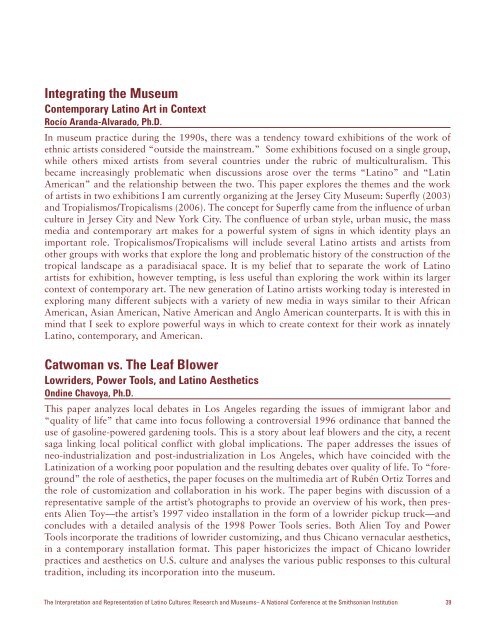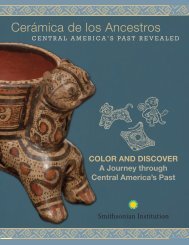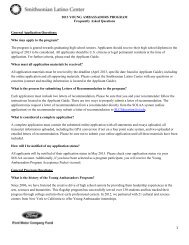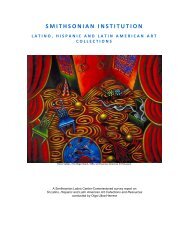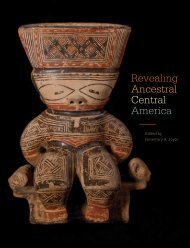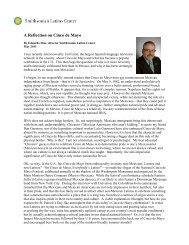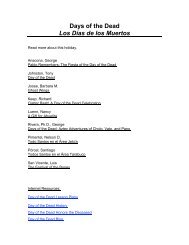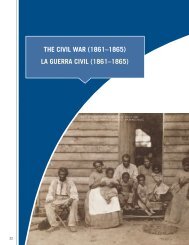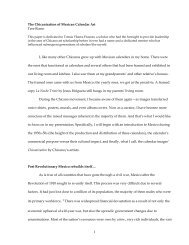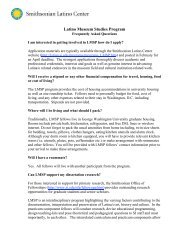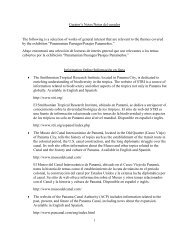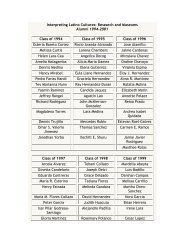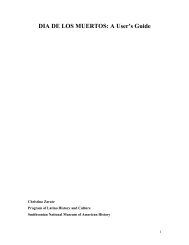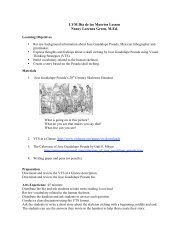Research and Museums - Smithsonian Latino Center - Smithsonian ...
Research and Museums - Smithsonian Latino Center - Smithsonian ...
Research and Museums - Smithsonian Latino Center - Smithsonian ...
You also want an ePaper? Increase the reach of your titles
YUMPU automatically turns print PDFs into web optimized ePapers that Google loves.
Integrating the MuseumContemporary <strong>Latino</strong> Art in ContextRocío Ar<strong>and</strong>a-Alvarado, Ph.D.In museum practice during the 1990s, there was a tendency toward exhibitions of the work ofethnic artists considered “outside the mainstream.” Some exhibitions focused on a single group,while others mixed artists from several countries under the rubric of multiculturalism. Thisbecame increasingly problematic when discussions arose over the terms “<strong>Latino</strong>” <strong>and</strong> “LatinAmerican” <strong>and</strong> the relationship between the two. This paper explores the themes <strong>and</strong> the workof artists in two exhibitions I am currently organizing at the Jersey City Museum: Superfly (2003)<strong>and</strong> Tropialismos/Tropicalisms (2006). The concept for Superfly came from the influence of urbanculture in Jersey City <strong>and</strong> New York City. The confluence of urban style, urban music, the massmedia <strong>and</strong> contemporary art makes for a powerful system of signs in which identity plays animportant role. Tropicalismos/Tropicalisms will include several <strong>Latino</strong> artists <strong>and</strong> artists fromother groups with works that explore the long <strong>and</strong> problematic history of the construction of thetropical l<strong>and</strong>scape as a paradisiacal space. It is my belief that to separate the work of <strong>Latino</strong>artists for exhibition, however tempting, is less useful than exploring the work within its largercontext of contemporary art. The new generation of <strong>Latino</strong> artists working today is interested inexploring many different subjects with a variety of new media in ways similar to their AfricanAmerican, Asian American, Native American <strong>and</strong> Anglo American counterparts. It is with this inmind that I seek to explore powerful ways in which to create context for their work as innately<strong>Latino</strong>, contemporary, <strong>and</strong> American.Catwoman vs. The Leaf BlowerLowriders, Power Tools, <strong>and</strong> <strong>Latino</strong> AestheticsOndine Chavoya, Ph.D.This paper analyzes local debates in Los Angeles regarding the issues of immigrant labor <strong>and</strong>“quality of life” that came into focus following a controversial 1996 ordinance that banned theuse of gasoline-powered gardening tools. This is a story about leaf blowers <strong>and</strong> the city, a recentsaga linking local political conflict with global implications. The paper addresses the issues ofneo-industrialization <strong>and</strong> post-industrialization in Los Angeles, which have coincided with theLatinization of a working poor population <strong>and</strong> the resulting debates over quality of life. To “foreground”the role of aesthetics, the paper focuses on the multimedia art of Rubén Ortiz Torres <strong>and</strong>the role of customization <strong>and</strong> collaboration in his work. The paper begins with discussion of arepresentative sample of the artist’s photographs to provide an overview of his work, then presentsAlien Toy—the artist’s 1997 video installation in the form of a lowrider pickup truck—<strong>and</strong>concludes with a detailed analysis of the 1998 Power Tools series. Both Alien Toy <strong>and</strong> PowerTools incorporate the traditions of lowrider customizing, <strong>and</strong> thus Chicano vernacular aesthetics,in a contemporary installation format. This paper historicizes the impact of Chicano lowriderpractices <strong>and</strong> aesthetics on U.S. culture <strong>and</strong> analyses the various public responses to this culturaltradition, including its incorporation into the museum.The Interpretation <strong>and</strong> Representation of <strong>Latino</strong> Cultures: <strong>Research</strong> <strong>and</strong> <strong>Museums</strong>– A National Conference at the <strong>Smithsonian</strong> Institution 39


